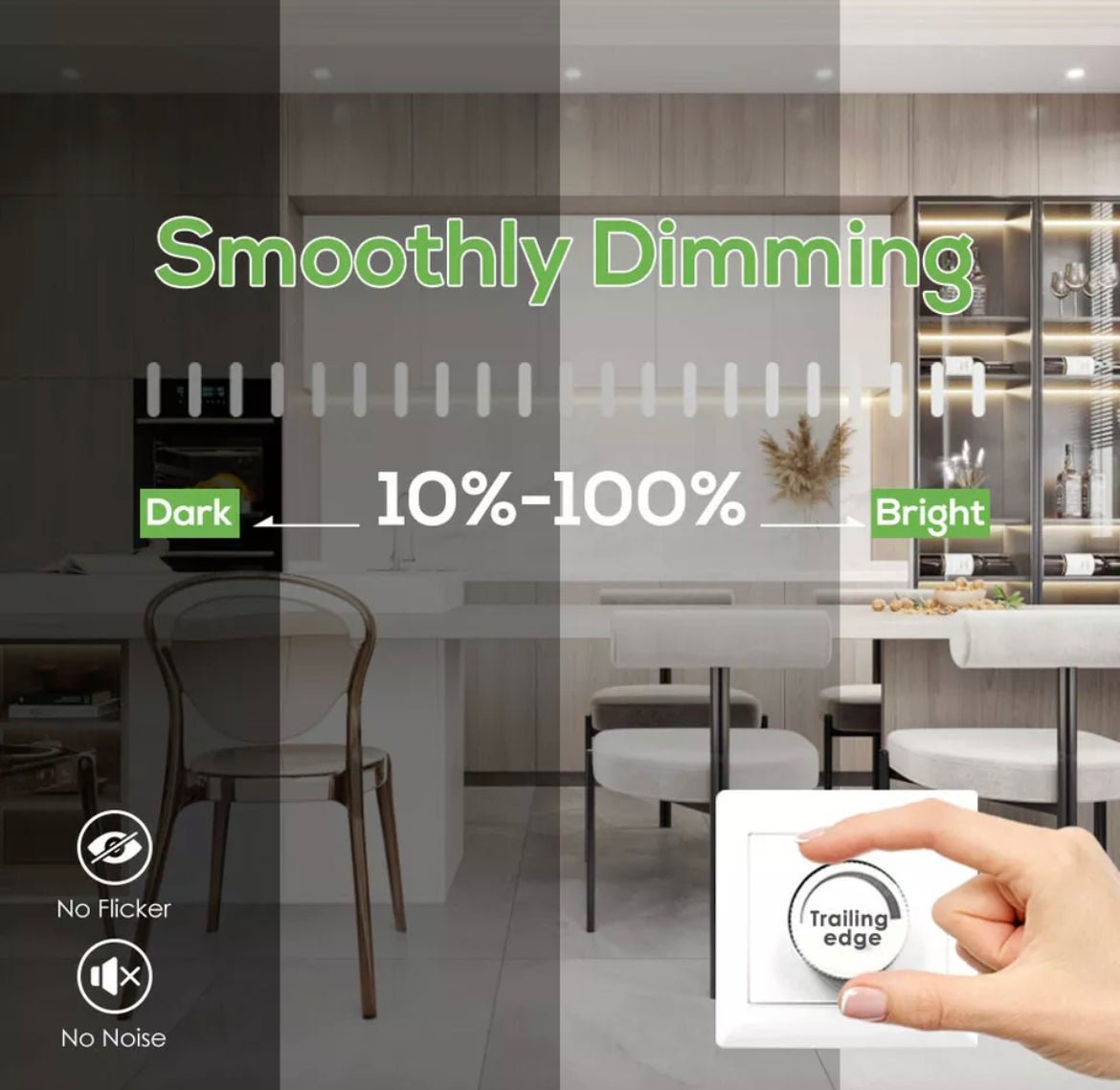I’m not a betting man, but if I was asked to wager why most people choose dimmable light bulbs over their standard counterparts, I’d probably go with their aesthetic potential.
By manipulating a tiny knob on one’s living room wall, it’s possible to completely alter the mood and ambience of a room at the drop of a hat. However, this actually carries with it a host of less obvious but equally favourable benefits such as reduced energy consumption and improved longevity – the longer your light bulbs are dimmed, the less energy they use and the longer they last. Got it? Great.
The proliferation of LED light bulbs in recent years has magnified these benefits yet further, with massively reduced wattages and hugely inflated lifetimes meaning that our light bulbs are now lasting longer than ever before.
But (there’s always a but), the advent of LED has also completely changed the dimmer game. Dimming your traditional incandescent light bulbs is still fairly straightforward, as I’ll explain below, but dimming LED light bulbs is somewhat trickier.
Can I use my existing dimmer to dim my LED light bulbs?
This would entirely depend on the type of dimmer you have. If you’ve been using your dimmer with incandescent or halogen light bulbs in the past, I’d wager (not a betting man, remember) that it’s a leading-edge dimmer, though this may not always be the case. This assumption is based on the idea that leading-edge dimmers have been around much longer and are therefore more ubiquitous than the newer trailing edge variant. In this instance, it’s best to check what kind of dimmer switch you have.
Leading Edge vs. Trailing-Edge Dimmers:
What’s the Difference?
Okay, so there are numerous types of dimmer switch available, but by far the most popular are the two that we’ll be concentrating on today – leading edge and trailing edge phase-cut dimmers.
As their name implies, both work by trimming the voltage at various phases of an alternating current’s sine wave, thereby reducing the power they send to the lamp.
For those of you that are still with us, it’s best to think of things as simply as this…
- Leading-edge dimmers are by the far the more popular of the two. They’ve been around much longer and are traditionally used to dim traditional incandescent and mains halogen light bulbs. This lends them a much higher wattage range (normally anywhere between 250W and 1000W) making them less likely to work with LED light bulbs, though this can be possible if the required tolerances are met.
- Trailing edge or LED ready dimmers have been designed specifically for use with LED light bulbs. As such, they share a number of characteristics that make them much more compatible, such as comparable wattage ranges and inherently digital makeup. The required wattages for these dimmers are much lower, making them more compatible with the lower wattage of LED light bulbs. Again though, trailing edge dimmers CAN also be used to dim traditional incandescent light bulbs if the wattage tolerances are still met, and they do this more effectively than using a leading-edge dimmer to dim LED light bulbs.
The best way to avoid confusion here is to check which dimmers are compatible with a certain type of light bulb. Most manufacturers rigorously test their products for compatibility with a range of dimmer switches and the results are normally readily available on their respective websites.
Dimming traditional incandescent light bulbs with a leading-edge dimmer
Dimming traditional incandescent light bulbs is relatively straightforward. Any leading edge dimmer carries with it a minimum and maximum load. As long as the light bulb or light bulbs paired with the dimmer sit within these tolerances, everything will work just fine.
The most common modules available generally limit their loads to 250W, 400W, 600W and 1000W at the top end and 25W, 40W, 100W and 150W at the bottom respectively. So, by way of example, if you use 4 x 100W incandescent light bulbs on the 400W module it’ll work just fine, but if you try a single 100W light bulb on the 1000W variant it would exhibit a number of problems, from flickering and excess noise to outright failure.
Dimming LED light bulbs with a trailing edge dimmer?
The mistake that many people make is assuming that trailing edge dimmers work in the same way as their leading-edge equivalents. This is a mistake – they are more expensive, infinitely more complex and absolutely brilliant when used properly.
They use a complicated, albeit sophisticated electronic system that yields a whole slew of benefits from silent operation to smoother control. They also generally have a lower minimum load than leading-edge dimmers, which is why they’re better suited to the more modest wattages associated with LED light bulbs.
How many LED light bulbs can I use on my dimmer?
One of the biggest problems people experience when installing trailing edge dimmer systems is working out just how many LED light bulbs it will support.
The main root of this problem is the massive disparity between incandescent and LED wattages. When a dimmer’s rated wattage is defined, it doesn’t take account of an LED light bulb’s drastically superior efficiency.
So, imagine we have a 400W trailing edge dimmer. It will accept 4 x 100W incandescent light bulbs without any issue and you can dim them to your heart’s content.
However, this doesn’t mean that you can then go and stuff 40 x 10W LED light bulbs on there and still make up the 400W. Oh no. This isn’t Disneyland. I’m afraid you’ll need to divide the dimmer’s maximum wattage by 10 to get its relevant value for LED light bulbs.
In this instance, it would be able to take 4 x 10W LED light bulbs or less, providing that the minimum wattage is still met.
However, it’s important to stress that this logic purely serves as a rule of thumb and is by no means exact. This is one of the myriad reasons why full compatibility cannot be guaranteed, which leads me neatly on to my next and final point…
Why are my LED light bulbs flickering or not dimming correctly?
You’re under-loading your dimmer!
This is a fairly common problem when people remove their old incandescent light bulbs and simply replace them with LED equivalents. Imagine you have two 60W filament light bulbs paired with a leading-edge dimmer that has a minimum load of 25W and a maximum load of 250W. In theory, this set up should work perfectly: the combined wattage of the light bulbs equals 120W, which is well above the dimmer’s minimum requirement but also well below its maximum. Now imagine that you decide you want to improve the efficiency of your home and invest in some sexy new LED light bulbs. These clock in at just 6W apiece and will absolutely eviscerate your lighting bill – result. Unfortunately, though their combined wattage of 12W gets nowhere near the 25W minimum and so they’ll most likely flicker, fail or blow your electrics. So what’s the solution? A low wattage trailing edge dimmer of course!
You’re over-loading your dimmer!
This is probably the most common mistake that people make when switching to LED, whereby they forget to divide the dimmer’s maximum wattage by 10 when considering its tolerances for LED. Remember to do this before assessing where your light bulb sits in terms of its wattage. If you’ve divided the dimmer’s rated wattage by 10 and your LED light bulb(s) cumulative wattage sits between its maximum and minimum values, crack on.
Plain bad luck.
Sometimes, you do all you can and the world still just wants to watch you struggle. You see, the virtue of LED light bulbs is that they don’t run on mains voltage alternating current, they instead use low voltage direct current. This bestows a number of their most laudable benefits, but it also means they require an electronic driver to convert the voltage they receive from the mains. These are built into the light bulb itself (which is why you can retrofit LED Lightbulbs Directly to existing fixtures without having to rewire them) but they need to be compatible with a dimmer’s components to dim properly. If they’re not, they won’t, and unfortunately, this isn’t something you have much control over – it all comes down to the manufacturer. This is why most manufacturers will normally provide a list of compatible dimmer switches that have been tried, tested and certified for use with their LED light bulbs.
What can I do to make sure my light bulbs dim properly?
Make sure your LED light bulbs are dimmable.
This is by far the easiest bit. A basic ability to read the light bulb’s packaging and product description should set you right here.
Upgrade your dimming circuit from leading edge to LED-ready trailing edge.
Leading-edge circuits CAN work with LED technology, but it’s much trickier to fathom, presents much more of a risk and won’t do wonders for the longevity of your light bulbs.
Use a compatible dimmer.
For the most part, we would recommend Diginet Phase adaptive range of dimmer switches. They’re compatible with an extensive number of LED light bulbs and carry very accommodating tolerances, from low minimum loads to generous maximum capacities.
Move to a non-dimmable circuit.
How much do you actually use your light bulb’s dimming function? Once a year at Christmas when the family’s round probably isn’t enough to justify the additional headache. The easiest and most efficient way to remove any potential set of issues is to simply remove the environment in which they’re allowed to arise.
Ensure that all your light bulbs are of the same type and from the same manufacturer.
This ensures that all the drivers in the circuit are made by the same people and therefore remain mutually compatible throughout. If you use a smattering of "X" brand light bulbs that are compatible with a particular dimmer but then intersperse them with light bulbs from another brand, you’re going to compromise your circuit as a whole.
Replace low voltage light bulbs with mains voltage versions.
This removes the need for external transformers and minimises the risk of compatibility issues here also. As above, if ALL of your light bulbs are made by "X" brand but require a third-party transformer to convert their voltage, it also needs to be compatible. If it isn’t… you get the picture.
Dimming LED light bulbs CAN certainly be tricky, but when done properly the benefits are endless, from the improved efficiency and longevity of the light bulbs to smooth, silent dimming that looks infinitely better than its incandescent equivalent.

